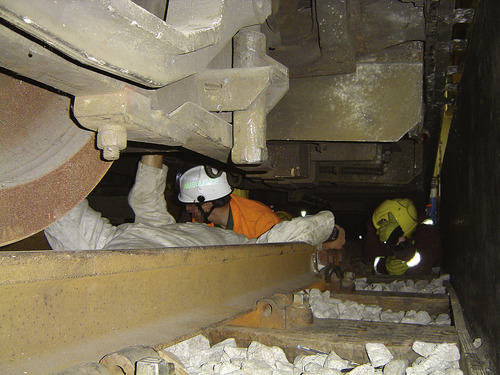CASE 12
 |
Incident
A 27-year-old female has been struck by an underground electric train. The tasking agency advises that the patient is trapped by her legs but is communicating.
Relevant information
▪ Aircraft: Rotary wing
▪ Ground resources: Landing site less than 200 m (656 feet) from entrance to scene.One land ambulance. Police Service. Underground train service personnel (including specialist rescue team). Fire & Rescue Service
▪ Retrieval options: Major trauma hospital 30 minutes by air
▪ Other: Patient location is 35 m (115 feet) underground at a metropolitan commuter train station. Ambient tunnel temperature 29°C (84°F)
Questions
12.1 What is your initial pre-hospital plan?
12.2 Describe arrival and scene management for a case like this.
After successful extrication from under the train, injuries are assessed as:
• Haemopneumothorax on right side.
• Extensive bruising over the right upper quadrant.
• Fractured pelvis.
• Traumatic brain injury.
The patient has undergone pre-hospital RSI. Current clinical information:
• P 105.
• BP 100/60 mmHg.
A right simple thoracostomy has been performed (see Case 14) and large-bore intravenous access established. The patient has received 750 mL of crystalloid.
Ten minutes into the flight home you notice the ETCO2 trace halves in size and the reading decreases from 35 to 15 mmHg (4.5 to 2.0 kPa).
12.3 Comment on the use of end tidal carbon dioxide monitoring in the pre-hospital arena and discuss your actions in this instance.
Discussion
12.1 This is a high-risk tasking particularly because of the presence of trains and electric current. Therefore, the PHR team should use safety helmets throughout the rescue. The mechanism of injury is significant and, as such, significant injuries should be expected – even if the initial clinical information suggests otherwise. Extra equipment (specifically additional oxygen) should be taken to the scene if the incident is underground as returning to the surface will be difficult during the rescue. Communications are also very restricted underground. Do not expect to be able to speak with the tasking agency whilst underground. In this incident, the nearest hospital also happens to be the most appropriate facility for this patient.
12.2 Many different teams will be activated to such an incident and the scene is likely to be chaotic. Scene control is vital for the efficient removal of the casualty. The PHR team’s role is to locate the key players from each of the other services and tell them who you are. Safety is paramount in this scenario and there are two main areas of concern: electric current and train movement.
Electric current
The energy in electrified train tracks is more than sufficient to kill. It is therefore imperative that the power has been switched off. In most systems, there will be a ‘line controller’ (or equivalent) who is in overall control of the trains on that section of line. The line controller will be in a control room remote from the scene but within telephone contact. It is vital that the PHR team speaks to the line controller to confirm that the power is off. If the incident is in a station there may be a tunnel phone direct to the line controller. The PHR team must not assume that the scene is safe simply because other services are already walking on the tracks. Ensuring the line controller is aware of the incident also reduces the risk that the power will be switched back on before the rescue is complete.
< div class='tao-gold-member'>
Only gold members can continue reading. Log In or Register to continue
Stay updated, free articles. Join our Telegram channel

Full access? Get Clinical Tree








